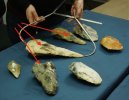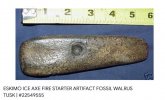I was an anthropology major and worked as an archeologist for a few years. Was originally accepted to a phd program to study neanderthal morphology, before I decided to go into ecology instead.
neanderthals were significantly more robustly built than early modern humans which were significantly stronger than people today. I don't think most people can fully appreciate how strong neanderthals likely were. their bones and muscle attachments were massive.
the statement that the hand axe was too big to be used is unbelievably ignorant. It's always been frustrating to me how archeologists/anthropologists consistently underestimate ancient people. even present day anthropologists will discuss how dim witted and primitive earlier anthropologists thought neandertals were which we've now discovered is not remotely correct, and at the same time continue to disregard or doubt any of their abilities/capabilities. The reason is that "we" think of ourselves as so superior and smart and 'better than' those who came before us, that we have to down play their abilities to make ourselves feel superior. Historians do the same thing.
if you are interested, look up the bracelet found at a Denisovan site in russia (denisovans were contemporaries of neanderthals who lived in asia while neanderthals lived in europe). the bracelet is super precise and intricate with a perfectly drilled hole in it suggesting the use of pretty sophistocated drills. but of course ancient people weren't capable of that kind of thing.
Humans have forgotten and lost more knowledge and skills to time than anyone would belive.
Oh and yes, J jfk1110 , the earths children book series is great. The clan of the cave bear is the first one. I had to read that in an anthropology class in the 90s and I've read it several other times. I've read the whole series. the later books are kind of pleistociene romance novels, as they pretty graphically detail the love life of Ayla and her love interest Jondalar, haha, but many of the tools, people and places referenced in the books are based on real archeological discoveries. They are fun to read.
neanderthals were significantly more robustly built than early modern humans which were significantly stronger than people today. I don't think most people can fully appreciate how strong neanderthals likely were. their bones and muscle attachments were massive.
the statement that the hand axe was too big to be used is unbelievably ignorant. It's always been frustrating to me how archeologists/anthropologists consistently underestimate ancient people. even present day anthropologists will discuss how dim witted and primitive earlier anthropologists thought neandertals were which we've now discovered is not remotely correct, and at the same time continue to disregard or doubt any of their abilities/capabilities. The reason is that "we" think of ourselves as so superior and smart and 'better than' those who came before us, that we have to down play their abilities to make ourselves feel superior. Historians do the same thing.
if you are interested, look up the bracelet found at a Denisovan site in russia (denisovans were contemporaries of neanderthals who lived in asia while neanderthals lived in europe). the bracelet is super precise and intricate with a perfectly drilled hole in it suggesting the use of pretty sophistocated drills. but of course ancient people weren't capable of that kind of thing.
Humans have forgotten and lost more knowledge and skills to time than anyone would belive.
Oh and yes, J jfk1110 , the earths children book series is great. The clan of the cave bear is the first one. I had to read that in an anthropology class in the 90s and I've read it several other times. I've read the whole series. the later books are kind of pleistociene romance novels, as they pretty graphically detail the love life of Ayla and her love interest Jondalar, haha, but many of the tools, people and places referenced in the books are based on real archeological discoveries. They are fun to read.


